Software Usb Card Reader Simple Read Type
The best retention card readers in 2022: copy images and video to your computer
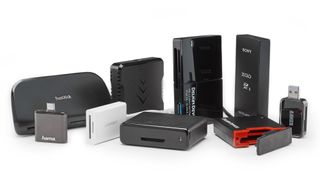
The best memory card readers are an like shooting fish in a barrel manner to make sure y'all can always become your images off your camera. With many laptops eschewing the SD card slot in favour of always-slimmer designs, having a memory card reader can exist practically essential. Sure, there's e'er the option to connect via USB, or wirelessly. Simply in practice this tin exist fiddly, and sometimes simply whipping the card out is the easier selection.
At that place are absolutely loads of USB bill of fare readers out in that location. Some are small, basically the size of USB flash drive (remember those?) and are priced as such; indeed, you can pick upwardly a adept card reader for very little in the way of greenbacks outlay. Alternatively, there are chunkier readers that basically function equally desktop docking stations. These can be a actually good way to streamline intense workflows, particularly as they tend to take really fast transfer speeds. It's undoubtedly a peachy way to brand sure you're getting the virtually out of your card speeds, especially if you lot've paid a premium for one of the best memory cards.
On this list, nosotros've made sure to include retentiveness bill of fare readers that run the gamut in terms of cost, but are all of practiced quality. Unlike cameras apply different card formats, so whether you lot use a standard SD menu, microSD cards, CompactFlash, CFexpress or XQD, there should exist a reader on this listing for you.
The best memory card readers in 2022


It may be a fairly cheap card reader, but the ImageMate Pro feels like a quality product, as information technology'south well built and weighty enough to sit securely on a desk-bound. And this is where it belongs, as at 122 ten 58 x 17mm, it'due south large by carte du jour reader standards.
A trio of card slots are spread neatly across the front, with CF, UHS-2 SD, and MicroSD to choose from. A detachable USB Type-A cable is provided, so you will need an adapter if you intend to plug in to a USB-C port.
Testing with a UHS-2 SD carte du jour yielded highly respectable video transfer speeds of 252MB/s read and 210MB/s write - not far off the much more expensive ProGrade Digital USB 3.ane Gen ii Dual-Slot Carte du jour Reader. 202MB/southward read and 107MB/s write figures in our testing when shifting images are too superb.
When it comes to UHS-I SD cards, maximum sustained transfer speeds of 96MB/south read and 83MB/southward write aren't quite class-leading, but not to the extent that you'd really notice in real-world employ.


With many current high-terminate cameras now utilizing both the CFexpress and SD card formats, it makes sense to get a bill of fare reader that as well takes both standards. This offer from Prograde Digital is a loftier quality choice and an ideal match for today'due south mirrorless and DSLR cameras.
Information technology measures a discrete 68x68x19mm and comes with a handy stick-on metal plate for attaching to your computer, and has a magnetic base for tucking it out of harm's way. The CFexpress slot sits at the elevation of the reader, while the SD slot is located below.
The readers employs a fast USB 3.2 Gen 2 interface, and nosotros clocked the CFexpress read/write speeds of 687MBs/645MBs - a respectable performance. In add-on to a USB Blazon-C connector cable, in that location's as well a Type-A cablevision in the box for attaching to older computers.
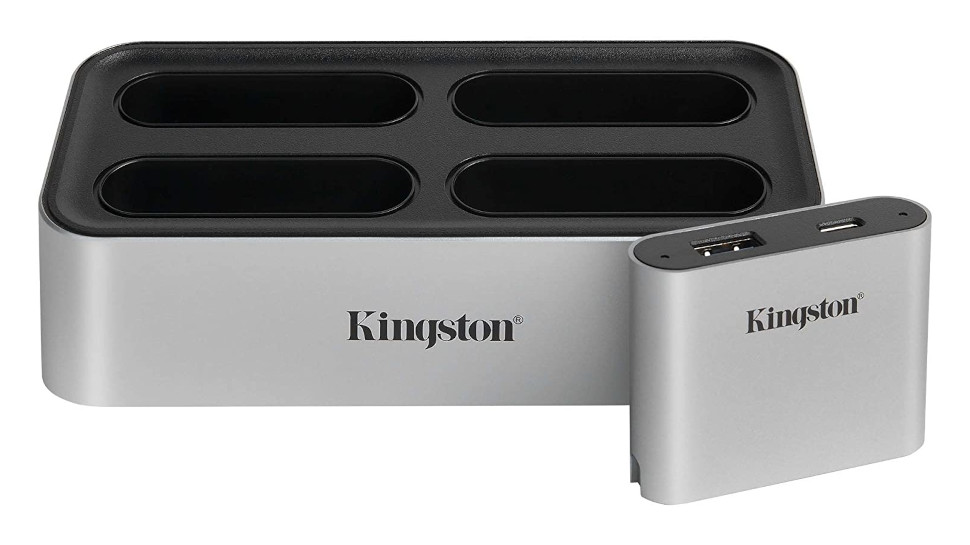
I thing we're all crying out for in the age of digital devices is a flake more simplicity. Fewer cables, simpler devices, more straightforward solutions for organising and transferring our files. The Kingston Workflow Station Dock is a go at realising that dream. It's a USB-C docking station equipped with a stack of SD carte du jour readers, allowing you to connect multiple USB-C or USB-A devices, and download from upwardly to eight cards at the same time.
What's too hugely useful is the aforementioned modular aspect, which means y'all can buy specific readers to adapt your needs. And so if yous have more than microSD cards than SD cards, you can set up the station accordingly. Or you lot could plug in 8 cameras via USB-C and download images from all of them simultaneously, if that's the sort of matter y'all're in a position to practice. Modules can too be used standalone, so you could take a single reader on a shoot and and so reconnect it to the principal dock after.
The whole thing does demand power to run, as information technology's more complex than other SD readers. In that location's besides the lack of CFExpress support currently, although, the modular design ways it would be easy to add this functionality in at a later appointment. All this does cost more than other readers on this list, and if you're a "one-card, one-camera" blazon of photographer, it'southward almost certainly more than y'all need.

With the latest laptops like the MacBook Pro ditching every port other than Thunderbolt/USB Type-C, it isn't only your memory card that y'all may be struggling to connect.
Kingston's Nucleum is a premium, metal-encased hub containing SD and MicroSD ports, plus two conventional USB Type-A ports, a full-size HDMI socket, and two USB Type-C ports, one of which is used equally a power socket to connect your MacBook's charger. At that place's a brusque hard-wired cable terminating in a USB Type-C plug, and all this from a device no larger than some standard card readers.
The SD slot is UHS-2 uniform, only sadly it couldn't exercise justice to our UHS-II test card, achieving relatively irksome video read/write speeds of 189MB/due south and 179MB/s respectively. 164MB/s read and 97MB/due south write rates for epitome transfers are ok, but nevertheless underwhelming. Fortunately if yous're using UHS-I SD cards, 96MB/southward and 83MB/s read/write figures are much more respectable.
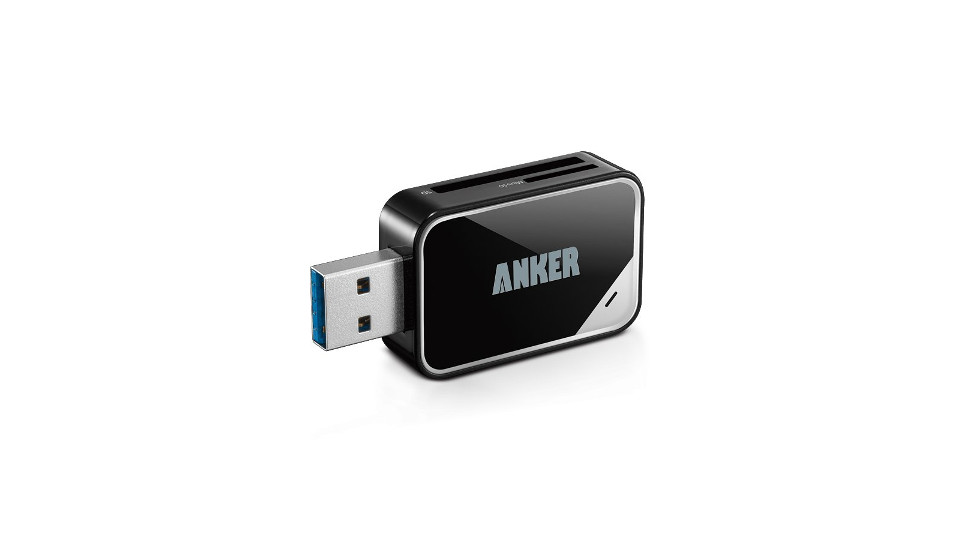
Despite beingness super-cheap, this little reader is a pleasingly capable device, able to attain speedy data transfer rates thanks to its USB 3.0 connection. It doesn't embrace all the card types, most notably missing out on XQD, CompactFlash and UHS-II SD (though it does UHS-I), however this isn't a problem for you, the Anker USB 3.0 Menu Reader will go the job washed chop-chop and efficiently.
It's likewise and then tiny that you can take it anywhere, measuring five.iii x ii.vii x 1.1cm and weighing a tiny 16g, and in that location'due south also an eighteen-month warranty to give you peace of mind. Need something simple and straightforward? This little reader is a solid buy.
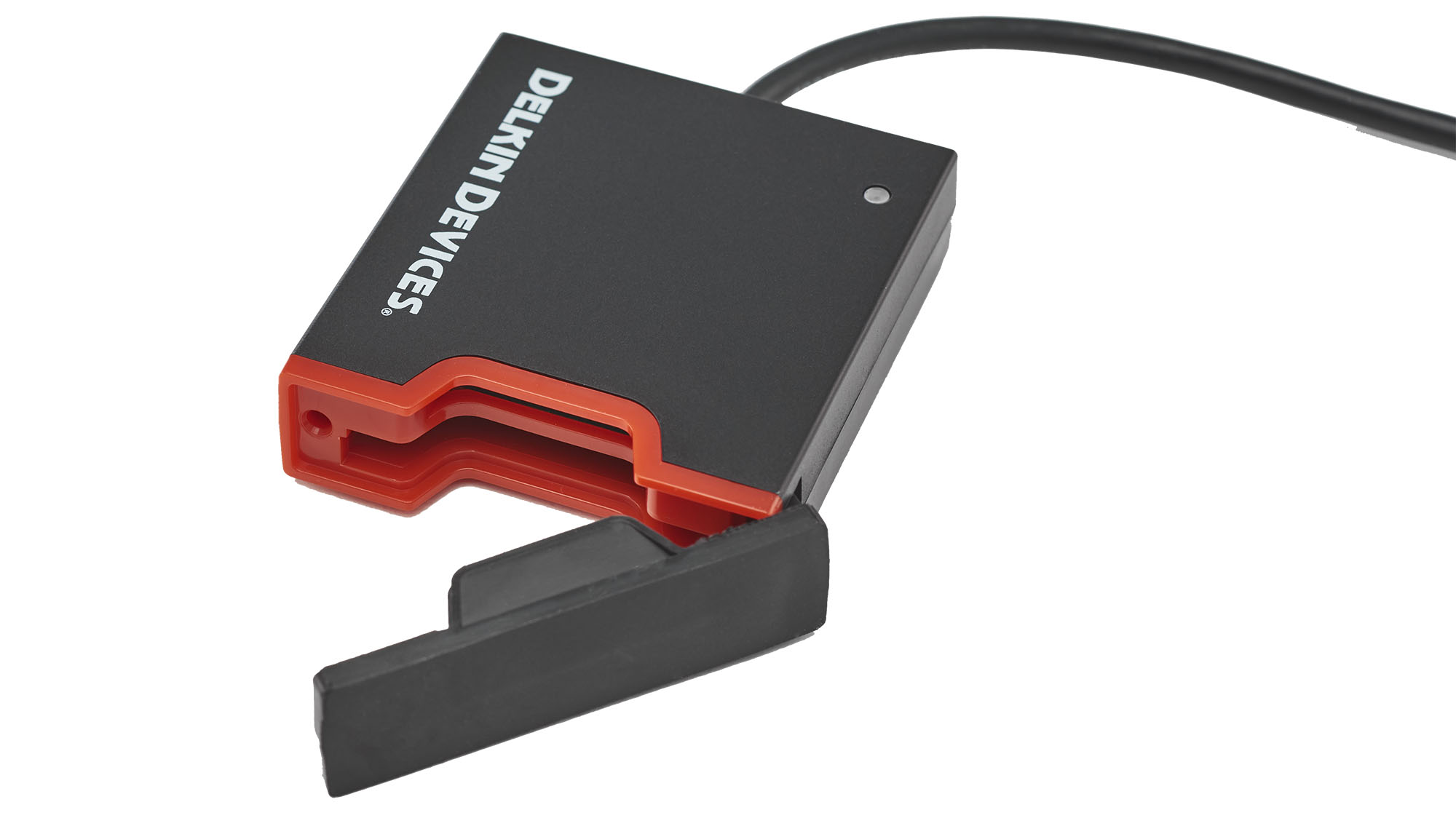
This carte du jour reader sports the classic philharmonic of SD and CompactFlash slots, both existence the fastest of their blazon - UHS-Two, and UDMA 7. You tin can utilise both simultaneously, and the case'southward blueprint means a bill of fare of each blazon tin exist stored inside the reader, protected by a hinged condom door that closes effectually them.
The 90cm USB Blazon-A lead is hardwired to the reader, so while you won't lose information technology, it can be slightly bad-mannered for transportation, and you'll need an adapter to connect this reader to a laptop like the current MacBook Pro.
Speed wise, nosotros could merely extract a max video read speed of 223MB/southward and 198MB/s write charge per unit from our UHS-2 SD carte - not awful, but some mode shot of another readers we've tested. Image transfer performance is worse all the same, with 152MB/southward read and 98MB/s write speeds beingness slower than average. Even with a UHS-I SD card the Delkin reader struggled, every bit 87MB/s read and 82MB/s write speeds are downwardly - albeit not past much - on what rival readers were capable of extracting from our test carte du jour with its 95/90MB/s max read/write rates.

Even our number one card reader option - Prograde'due south dual-slot CFexpress and SD card reader - will struggle to max out the transfer speeds of almost CFexpress Type B cards. That'southward considering its USB iii.2 Gen 2 interface tops out at ane.25 gigabytes per second, whereas many CFexpress cards tin can reach over i.half-dozen gigabytes per second. A faster connection is therefore needed, and that's where Thunderbolt 3 comes in. In our testing, real-globe image transfers clocked in at a stellar 846MBs/693MBs read/write – that's under 12 seconds to read 10GB worth of images.
Not but tin can this reader get the virtually out of a CFexpress B card thanks to its Thunderbolt 3 connexion, it's also compatible with the older (simply physically interchangeable) XQD card format. Useful, as cameras like the Nikon Z half-dozen and Z 7 started out with a socket for an XQD card, which was later firmware upgraded to be CFexpress compatible. Merely frustratingly, the majority of CFexpress readers won't read an XQD carte du jour despite the two being physically identical. This reader from Prograde Digital bucks that trend, but at that place are a couple of caveats. It won't read XQD cards out of the box – you first demand to download and install a driver from Sony, though this proved a straightforward process on our Macbook Pro.
This reader is relatively big and bulky at 98x98x24mm, just it has a magnetic base and comes with a metallic sticker to attach to your computer to keep information technology out of the style.

Around the aforementioned size and shape as a computer mouse, Sandisk'due south Extreme Pro CFexpress card reader is a nicely designed piece of kit. The jump-loaded retentiveness menu slot has a pleasing action too, with a gentle button of the retentiveness carte ejecting it from the reader.
In our testing, this reader hit a mighty impressive 718MB/s sustained read speed when transferring ane large 4K video file. Paradigm read/write rates of 534/410MB/s are just as incredible, easily eclipsing even the fastest UHS-II SD cards.
The only slight disappointment is that CFexpress cards are capable of fifty-fifty college transfer speeds - up to 1700MB/s. The clogging here is likely the reader's USB 3.1 Gen 2 connectedness, which though very fast, can't keep up with the blistering performance bachelor from CFexpress cards. But if you tin can live with that, this Sandisk CFexpress reader is a superb selection.
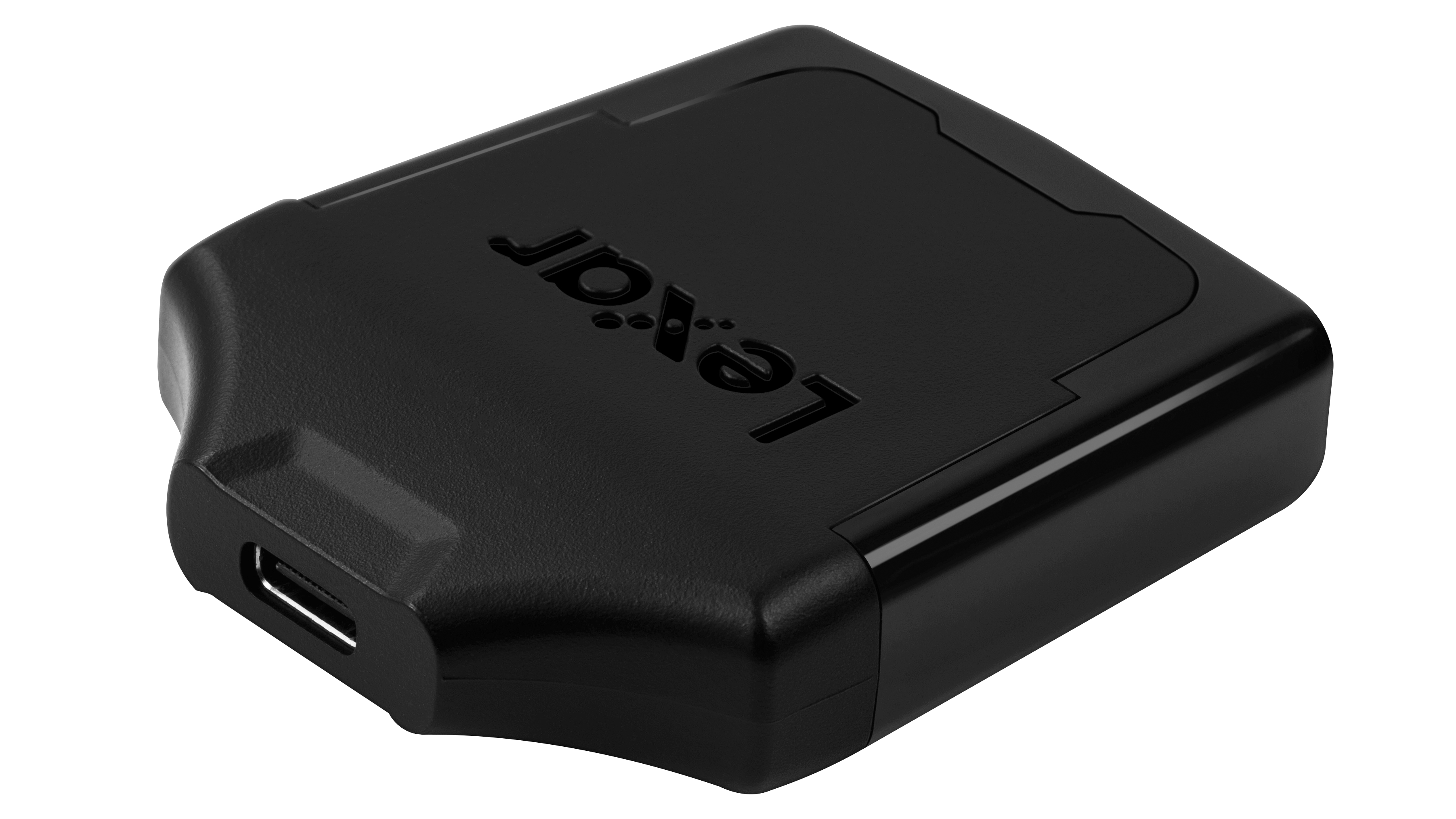
At just 56.2 x 47.28 x 12.85mm, this CFexpress reader sports a peachy design that's fiddling bigger than a CFexpress card itself, and cheers to a detachable USB-C cable, the reader will easily skid into a jeans pocket or stash in any kit pocketbook.
USB 3.i Gen 2 connectivity ensures a maximum 10Gbit/due south transfer rate, with Lexar challenge read/write speeds of up to 1050MB/s - that'southward quick, though even this fast connection but isn't enough to to fully exploit the maximum 1750MB/due south read speed of Lexar'south Professional Type B CFexpress cards. Nosotros clocked this reader/card combo at a maximum 1039MB/s using the CrystalDiskMark speed benchmark software, verifying Lexar's 1050MB/s claim. Existent world image read/write speeds of 543/384MB/s are as well hugely respectable, and are comparable to Sandisk'south CFexpress reader.
This reader is also backward uniform with USB 2.0 if required, and a USB-C to USB-A cable is included for employ with older computers.
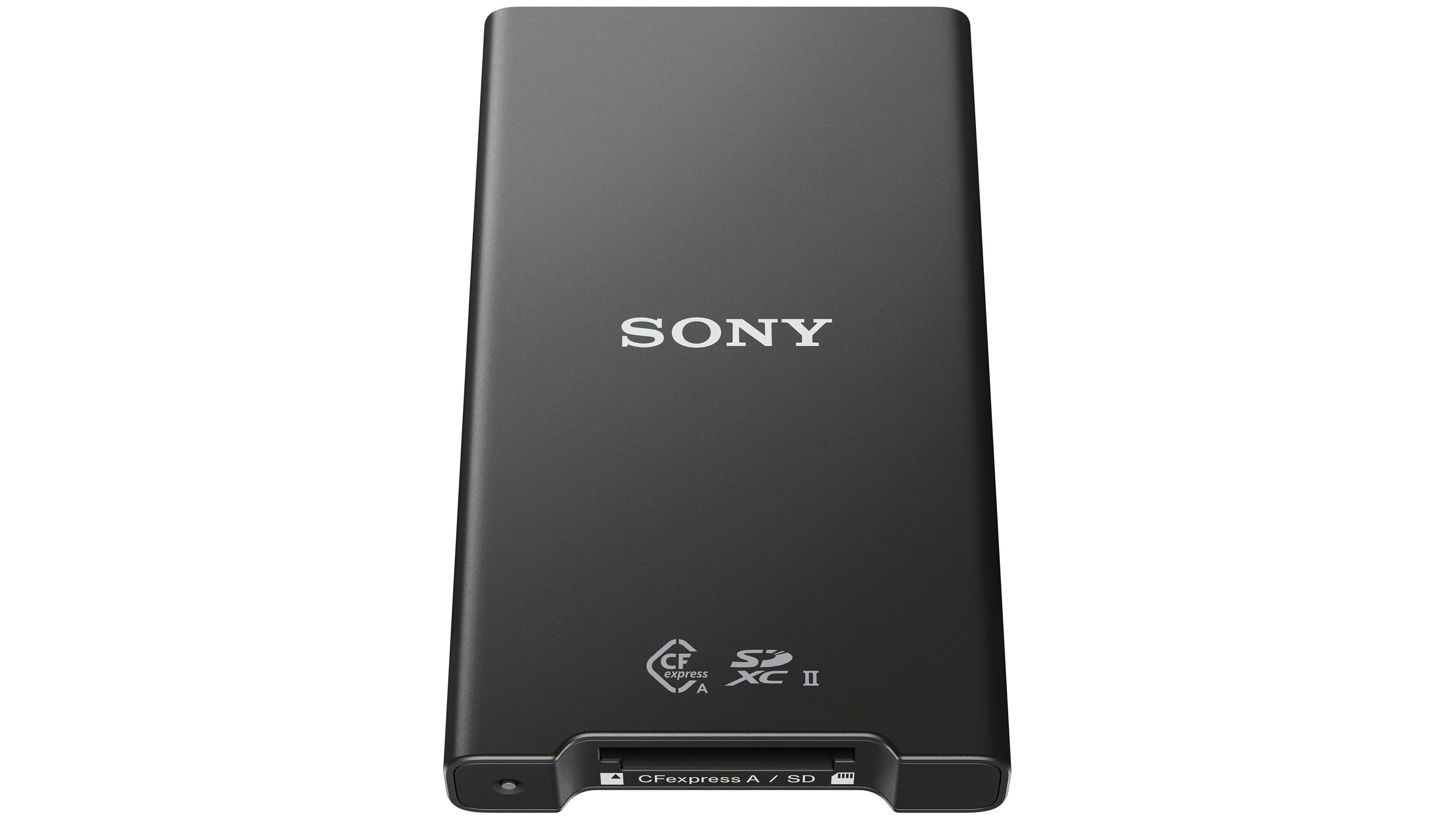
Sony's CFexpress Type A/SD Card Reader was launched at the same time every bit the Sony a7S III's release, as this was the get-go camera to utilize the CFexpress Type A memory card format (the physically larger Type B cards already being commonplace). With such a new CFexpress variant, and very few manufacturers currently producing Type A cards or readers, it's little surprise that this reader is ludicrously expensive. At least it uses a fast USB iii.ii Gen ii interface for a maximum theoretical transfer speed of 1250MB/s - plenty fast plenty to let a 800MB/south CFexpress Type A card transfer at its maximum speed. The MRW-G2 card reader as well supports SDXC/SDHC UHS-I and UHS-II cards for added versatility, going some way to justify the loftier selling price.

CFexpress card readers aren't all that common, or in this example, inexpensive. Doubly frustrating, every bit Sony doesn't fifty-fifty include an SD slot to at least give you a little extra versatility (XQD compatibility is included, though that's due to XQD cards beingness physically interchangeable with CFexpress Type B).
At least the USB 3.i Gen two (x Gbps) interface is speedy, equating to a maximum transfer speed of 1250 megabytes per second. Still, fifty-fifty this is still some way brusk of the 1700+MB/due south read speed that the best CFexpress cards tin can manage. even this can't let the fastest CFexpress Type B cards run at max speed.
Consequently, if you really want to max out the transfer speed of your CFexpress Type B carte, nosotros'd recommend the Prograde Digital Thunderbolt iii CFexpress reader (higher up) instead.
5 things to await for in a carte du jour reader
1. Connexion type
Many bill of fare readers at present connect to your computer using a USB-C plug, but adapters are readily available to convert to normal USB.
2. USB speed
USB 3.i Gen 2 is twice equally fast than Gen 1, but few readers utilize it, and even fewer memory cards are fast enough to exploit Gen 2.
3. UHS-I vs UHS-II
UHS-2 SD cards are faster, and all the readers here are compatible. UHS-I card readers volition read UHS-II cards, just slower.
4. Wire information technology upwards
Some readers utilise a USB cablevision that'southward hard-wired to the reader trunk, which can be problematic if the cable ever gets damaged.
five. Extra ports
With fewer and fewer ports on the sides of mod laptops, a card reader hub with extra USB sockets may be just the ticket.
Also read:
- The all-time retentiveness cards for your photographic camera - SD, microSD, CF and XQD
- All-time microSD cards
- Best flash drives
- The best monitors for photographers
- All-time SD card deals
- Best laptops for photo editing
Related articles
Source: https://www.digitalcameraworld.com/buying-guides/the-best-memory-card-readers
0 Response to "Software Usb Card Reader Simple Read Type"
Postar um comentário